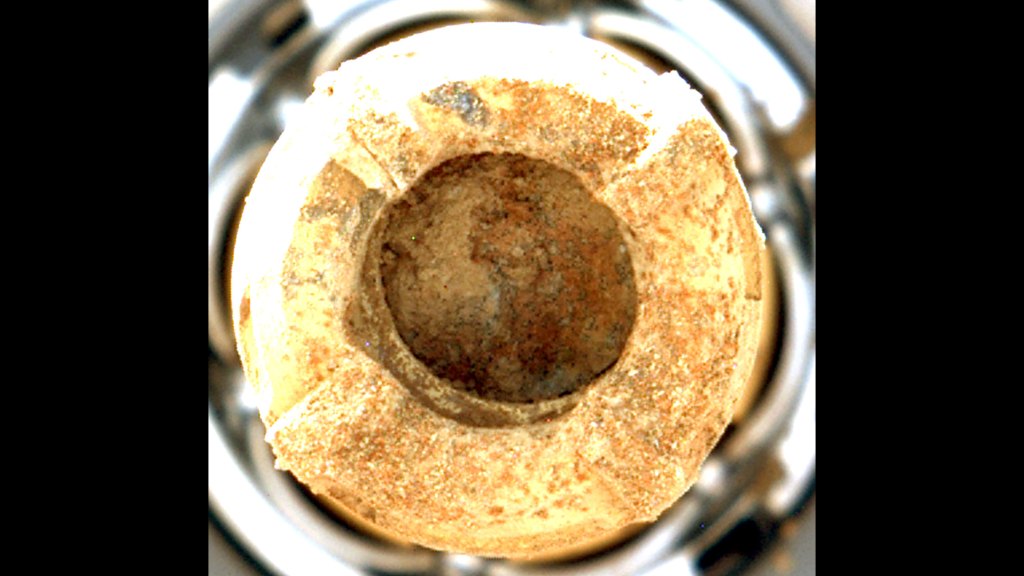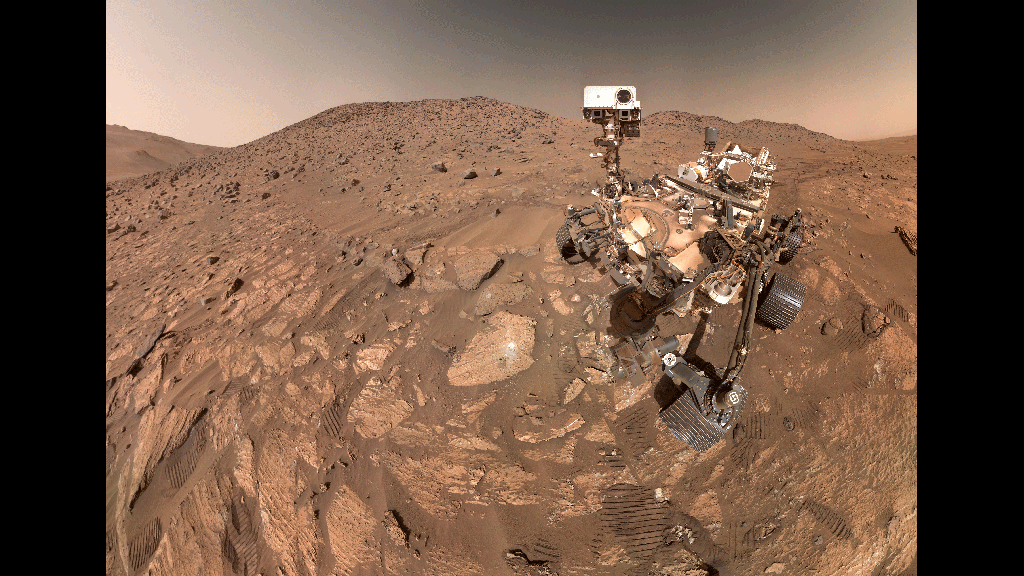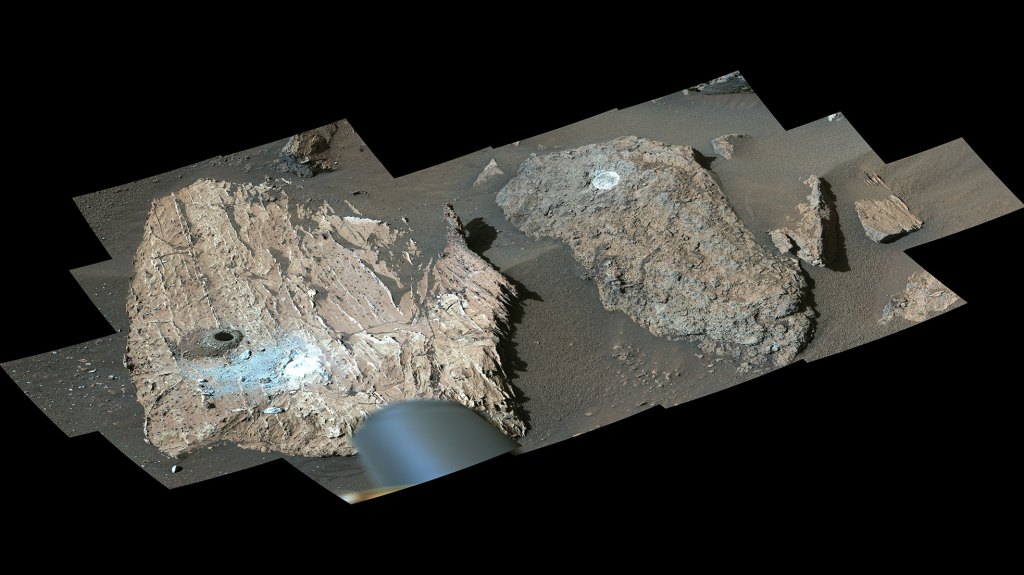Η επιφάνεια του πλανήτη Άρη από το Διάστημα / Φωτογραφία: Shutterstock
26/07/2024 17:09
Ευρήματα σε πέτρωμα του πλανήτη Άρη, που εντόπισε το ρόβερ «Perseverance», μπορεί να δείχνουν ότι στον Κόκκινο Πλανήτη κάποτε υπήρχε ζωή, σύμφωνα με τους επιστήμονες της NASA.
Βέβαια, δεν πρόκειται για στοιχεία που υποδηλώνουν περίπλοκες μορφές ζωής, αλλά για δείγματα που δίνουν στοιχεία για την ύπαρξη μικροβίων στην επιφάνεια του Άρη, στο παρελθόν -εάν επιβεβαιωθούν οι υποθέσεις.
Ειδικότερα, πρόκειται για ένα πέτρωμα που βρέθηκε από το ρόβερ της NASA στον Άρη και περιέχει χαρακτηριστικά που υποδηλώνουν ότι μπορεί να φιλοξένησε μικροβιακή ζωή πριν από δισεκατομμύρια χρόνια.

Το πέτρωμα «Cheyava Falls» στον πλανήτη Άρη που εξετάζουν οι επιστήμονες
Ο βράχος, σε σχήμα αιχμής βέλους, που ονομάστηκε «Cheyava Falls», ανακαλύφθηκε από το ρόβερ «Perseverance» της NASA στις 21 Ιουλίου, καθώς το ρομποτικό όχημα κινούνταν κατά μήκος της βόρειας άκρης του Neretva Vallis, μιας αρχαίας κοιλάδας του Κόκκινου Πλανήτη.
Η ανάλυση του βράχου αποκάλυψε σημάδια οργανικού υλικού, επιφανειακές κηλίδες παρόμοιες με αυτές που σχετίζονται με απολιθωμένα μικρόβια στη Γη και ενδείξεις ότι κάποτε περνούσε νερό μέσα από τον βράχο, ανέφερε η υπηρεσία.
Στο αρχαίο παρελθόν, ο Άρης ήταν θερμότερος και πιο υγρός πλανήτης. Αν αναπτύχθηκε ζωή ποτέ εκεί, οι ερευνητές πιστεύουν ότι τα ίχνη της θα πρέπει να παραμένουν στα πετρώματά του με τη μορφή οργανικού υλικού και ενδεχομένως απολιθωμένων υπολειμμάτων.

Ίσως το πιο σημαντικό πέτρωμα που έχει βρει το Perseverance στον Κόκκινο Πλανήτη
Ο Κεν Φάρλεϊ, επιστήμονας της αποστολής στο Ινστιτούτο Τεχνολογίας της Καλιφόρνιας, δήλωσε ότι το «Cheyava Falls» είναι «το πιο αινιγματικό, πολύπλοκο και δυνητικά σημαντικό πέτρωμα που έχει διερευνηθεί από το Perseverance», αν και η ομάδα ξεκαθαρίζει ότι τα χαρακτηριστικά του μπορεί να έχουν προκαλέσει μη βιολογικές διεργασίες.
«Από τη μία πλευρά, έχουμε την πρώτη μας συναρπαστική ανίχνευση οργανικού υλικού, χαρακτηριστικές πολύχρωμες κηλίδες, ενδεικτικές χημικών αντιδράσεων που η μικροβιακή ζωή θα μπορούσε να χρησιμοποιήσει ως πηγή ενέργειας, και σαφείς ενδείξεις ότι το νερό, απαραίτητο για τη ζωή, πέρασε κάποτε μέσα από τον βράχο», δήλωσε ο Φάρλεϊ.
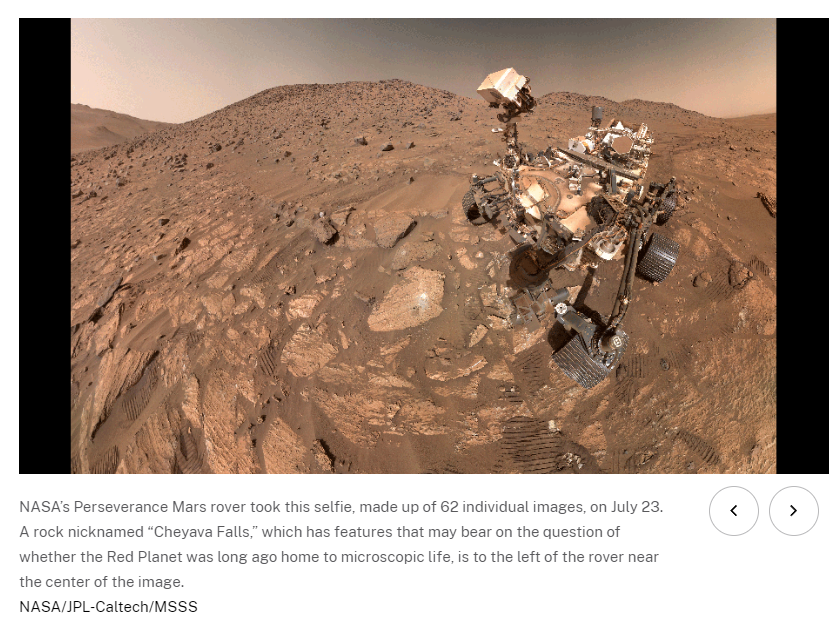
«Από την άλλη πλευρά, δεν μπορέσαμε να προσδιορίσουμε ακριβώς πώς σχηματίστηκε το πέτρωμα και σε ποιον βαθμό τα κοντινά πετρώματα μπορεί να έχουν θερμάνει το “Cheyava Falls” και να έχουν συμβάλει σε αυτά τα χαρακτηριστικά», συμπλήρωσε.
Οι σαρώσεις του βράχου «Cheyava Falls» από το όργανο Sherloc του Perseverance υποδεικνύουν ότι περιέχει οργανικές ενώσεις. Τέτοια μόρια με βάση τον άνθρακα θεωρούνται τα δομικά στοιχεία της ζωής, αλλά μπορούν επίσης να παραχθούν από μη βιολογικές διαδικασίες.
Τον βράχο διατρέχουν μεγάλες λευκές φλέβες φωσφορικού ασβεστίου. Ανάμεσά τους υπάρχουν λωρίδες κοκκινωπού υλικού, πιθανότατα αιματίτη, μια από τις ενώσεις οξειδίου του σιδήρου που δίνει στον Άρη το χρώμα της σκουριάς.
Η προσεκτικότερη εξέταση αποκάλυψε κηλίδες, οι οποίες περιβάλλονται από δακτυλίους που περιέχουν σίδηρο και φωσφορικό άλας.
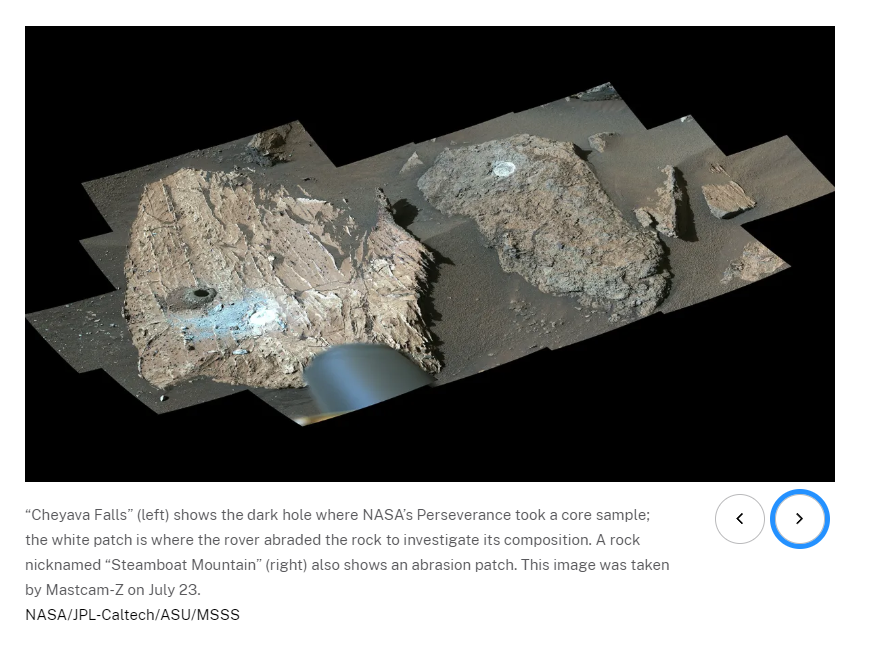
Τι εκτιμούν οι επιστήμονες, γιατί είναι δύσκολη η μεταφορά πετρωμάτων από τον Άρη στη Γη
Ο Ντέιβιντ Φλάνερι, αστροβιολόγος στο Πανεπιστήμιο Τεχνολογίας του Κουίνσλαντ στην Αυστραλία και μέλος της αποστολής, χαρακτήρισε τις κηλίδες «μεγάλη έκπληξη», επειδή στη Γη παρόμοια χαρακτηριστικά «συχνά συνδέονται με απολιθωμένα μικρόβια».
Οι λευκές κηλίδες μπορούν να σχηματιστούν στους βράχους μέσω χημικών αντιδράσεων που αφορούν τον αιματίτη, παράγοντας σίδηρο και φωσφορικά άλατα, καθώς και ενέργεια με την οποία θα μπορούσαν να ζήσουν τα μικρόβια. Αν και τα χαρακτηριστικά είναι ενδιαφέροντα, τίποτα από όσα έχουν παρατηρηθεί δεν φαίνεται να είναι πραγματικό απολιθωμένο μικρόβιο.

Οι ερευνητές επιθυμούν απεγνωσμένα να πάρουν στα χέρια τους δείγματα για πιο ενδελεχή έρευνα, αλλά τα σχέδια της NASA για να μεταφερθούν τα πετρώματα στη Γη έχουν συναντήσει δυσκολίες.
Η αποστολή της μεταφοράς των δειγμάτων από τον Άρη έχει υπερβεί τον προϋπολογισμό των 11 δισ. δολαρίων και έχει καθυστερήσει σημαντικά, χωρίς να υπάρχει προοπτική τα πετρώματα να έλθουν στη Γη πριν από το 2040. Η NASA αναζητεί εταιρείες που θα επιτύχουν να φέρουν τα δείγματα από τον Άρη νωρίτερα και με χαμηλότερο κόστος.
«Αυτό είναι το νόημα της μεταφοράς δειγμάτων από τον Άρη. Δεν έχουμε ξαναδεί ποτέ κάτι τέτοιο από τον Άρη, ούτε στις συλλογές μας από αρειανούς μετεωρίτες, ούτε με το Mars Science Laboratory ούτε με άλλους προσεδαφιστές» δήλωσε ο καθηγητής Τζον Μπρίτζες, επιστήμονας που συμμετέχει στην αποστολή Mars Science Laboratory της NASA στο Πανεπιστήμιο του Λέισεστερ.
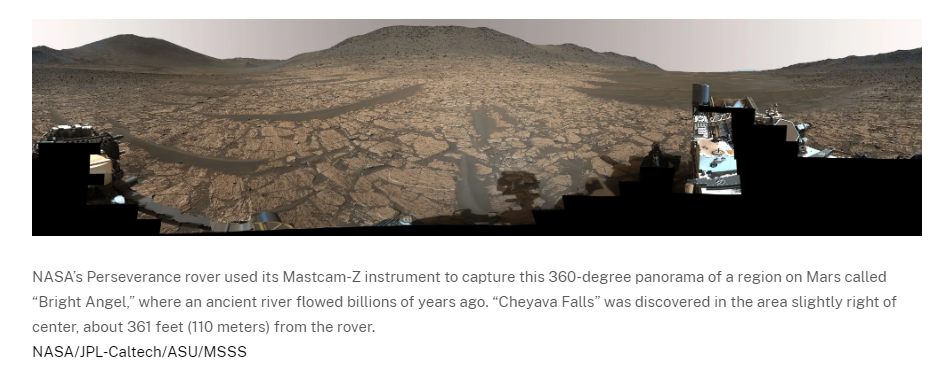
Ο καθηγητής Τσαρλς Κόκελ, αστροβιολόγος στο Πανεπιστήμιο του Εδιμβούργου, δήλωσε:
«Αν και τα χαρακτηριστικά αυτά δεν παρέχουν αδιαμφισβήτητες αποδείξεις ζωής, επιβεβαιώνουν ότι ο Άρης ήταν ένας πολύ δυναμικός πλανήτης με όλα τα συστατικά για τη ζωή, συμπεριλαμβανομένου του οργανικού άνθρακα».
«Πρέπει να φέρουμε πίσω δείγματα, ή, κατά την άποψή μου, ακόμα καλύτερα, να στείλουμε ανθρώπους, για να διαπιστώσουμε αν βλέπουμε τις υπογραφές της ζωής», σημείωσε.

Η καθηγήτρια Μόνικα Γκράντι, πλανητικός και διαστημικός επιστήμονας στο Ανοικτό Πανεπιστήμιο, επισήμανε:
«Αυτός είναι ένας πραγματικά εκπληκτικός βράχος. Μου τρέχουν τα σάλια και μόνο που τον κοιτάζω. Ο συνδυασμός διαφορετικών τύπων ορυκτών, που είναι τοποθετημένα με τον τρόπο αυτόν, μου θυμίζει κάποιες από τις υφές που βρίσκονται σε αρχαία γήινα πετρώματα, όπου διατηρούνται ίχνη από σκουλήκια που σκάβουν. Προφανώς, δεν λέω ότι υπήρχαν λαγούμια στον Άρη, αλλά ανυπομονώ να δω τι άλλο θα αποκαλύψει το Perseverance σε αυτό το μέρος της εξερεύνησής του».
NASA’s Perseverance Rover Scientists Find Intriguing Mars Rock
The six-wheeled geologist found a fascinating rock that has some indications it may have hosted microbial life billions of years ago, but further research is needed.
A vein-filled rock is catching the eye of the science team of NASA’s Perseverance rover. Nicknamed “Cheyava Falls” by the team, the arrowhead-shaped rock contains fascinating traits that may bear on the question of whether Mars was home to microscopic life in the distant past.
Analysis by instruments aboard the rover indicates the rock possesses qualities that fit the definition of a possible indicator of ancient life. The rock exhibits chemical signatures and structures that could possibly have been formed by life billions of years ago when the area being explored by the rover contained running water. Other explanations for the observed features are being considered by the science team, and future research steps will be required to determine whether ancient life is a valid explanation.
The rock — the rover’s 22nd rock core sample — was collected on July 21, as the rover explored the northern edge of Neretva Vallis, an ancient river valley measuring a quarter-mile (400 meters) wide that was carved by water rushing into Jezero Crater long ago.
“We have designed the route for Perseverance to ensure that it goes to areas with the potential for interesting scientific samples,” said Nicola Fox, associate administrator, Science Mission Directorate at NASA Headquarters in Washington. “This trip through the Neretva Vallis riverbed paid off as we found something we’ve never seen before, which will give our scientists so much to study.”
Multiple scans of Cheyava Falls by the rover’s SHERLOC (Scanning Habitable Environments with Raman & Luminescence for Organics & Chemicals) instrument indicate it contains organic compounds. While such carbon-based molecules are considered the building blocks of life, they also can be formed by non-biological processes.
“Cheyava Falls is the most puzzling, complex, and potentially important rock yet investigated by Perseverance,” said Ken Farley,Perseverance project scientist of Caltech in Pasadena. “On the one hand, we have our first compelling detection of organic material, distinctive colorful spots indicative of chemical reactions that microbial life could use as an energy source, and clear evidence that water — necessary for life — once passed through the rock. On the other hand, we have been unable to determine exactly how the rock formed and to what extent nearby rocks may have heated Cheyava Falls and contributed to these features.”

Other details about the rock, which measures 3.2 feet by 2 feet (1 meter by 0.6 meters) and was named after a Grand Canyon waterfall, have intrigued the team, as well.
How Rocks Get Their Spots
In its search for signs of ancient microbial life, the Perseverance mission has focused on rocks that may have been created or modified long ago by the presence of water. That’s why the team homed in on Cheyava Falls.
“This is the kind of key observation that SHERLOC was built for — to seek organic matter as it is an essential component of a search for past life,” said SHERLOC’s principal investigator Kevin Hand of NASA’s Jet Propulsion Laboratory in Southern California, which manages the mission.
Running the length of the rock are large white calcium sulfate veins. Between those veins are bands of material whose reddish color suggests the presence of hematite, one of the minerals that gives Mars its distinctive rusty hue.
When Perseverance took a closer look at these red regions, it found dozens of irregularly shaped, millimeter-size off-white splotches, each ringed with black material, akin to leopard spots. Perseverance’s PIXL (Planetary Instrument for X-ray Lithochemistry) instrument has determined these black halos contain both iron and phosphate.

“These spots are a big surprise,” said David Flannery, an astrobiologist and member of the Perseverance science team from the Queensland University of Technology in Australia. “On Earth, these types of features in rocks are often associated with the fossilized record of microbes living in the subsurface.”
Spotting of this type on sedimentary terrestrial rocks can occur when chemical reactions involving hematite turn the rock from red to white. Those reactions can also release iron and phosphate, possibly causing the black halos to form. Reactions of this type can be an energy source for microbes, explaining the association between such features and microbes in a terrestrial setting.
In one scenario the Perseverance science team is considering, Cheyava Falls was initially deposited as mud with organic compounds mixed in that eventually cemented into rock. Later, a second episode of fluid flow penetrated fissures in the rock, enabling mineral deposits that created the large white calcium sulfate veins seen today and resulting in the spots.
Morgan Cable, a scientist on the Perseverance team, takes a closer look. Credit: NASA/JPL-Caltech
Another Puzzle Piece
While both the organic matter and the leopard spots are of great interest, they aren’t the only aspects of the Cheyava Falls rock confounding the science team. They were surprised to find that these veins are filled with millimeter-size crystals of olivine, a mineral that forms from magma. The olivine might be related to rocks that were formed farther up the rim of the river valley and that may have been produced by crystallization of magma.
If so, the team has another question to answer: Could the olivine and sulfate have been introduced to the rock at uninhabitably high temperatures, creating an abiotic chemical reaction that resulted in the leopard spots?
“We have zapped that rock with lasers and X-rays and imaged it literally day and night from just about every angle imaginable,” said Farley. “Scientifically, Perseverance has nothing more to give. To fully understand what really happened in that Martian river valley at Jezero Crater billions of years ago, we’d want to bring the Cheyava Falls sample back to Earth, so it can be studied with the powerful instruments available in laboratories.”
More Mission Information
A key objective of Perseverance’s mission on Mars is astrobiology, including caching samples that may contain signs of ancient microbial life. The rover will characterize the planet’s geology and past climate, to help pave the way for human exploration of the Red Planet and as the first mission to collect and cache Martian rock and regolith.
NASA’s Mars Sample Return Program, in cooperation with ESA (European Space Agency), is designed to send spacecraft to Mars to collect these sealed samples from the surface and return them to Earth for in-depth analysis.
The Mars 2020 Perseverance mission is part of NASA’s Moon to Mars exploration approach, which includes Artemis missions to the Moon that will help prepare for human exploration of the Red Planet.
NASA’s Jet Propulsion Laboratory, which is managed for the agency by Caltech, built and manages operations of the Perseverance rover.
For more about Perseverance:






